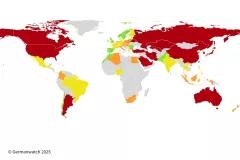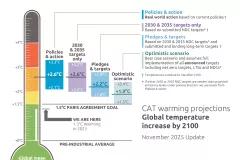Written by Thomas Day, Frauke Röser, Takeshi Kuramochi, Carsten Warnecke, Markus Hagemann, Hanna Fekete, Marie Kurdziel, Sofia Gonzales, Niklas Höhne
On 12 December 2015, 195 countries made history when they agreed the first truly global international climate change agreement, marking a major milestone in a political process that has spanned decades. What is the significance of the agreement for the future of climate change mitigation efforts? NewClimate Institute reflects on the implications of the 2015 Paris Agreement for reducing greenhouse gas emissions.
The long term goal sends a clear signal for decarbonisation to policy makers, investors and the business community
The language of the text regarding the purpose of the convention and the long term goal, has been a subject of particular importance for Parties and observers in recent years, and was a major focus point of the negotiations in Paris.
Most governments and observers called for increasing the ambition of the long term goal from that of limiting global temperature increase by the end of the century to a maximum of 2°C compared to pre-industrial times, to a more ambitious goal of 1.5°C, in recognition of the IPCC’s Fifth Assessment Report. The report finds that the impacts of a 2°C temperature increase entail grave consequences in many parts of the world, including the likely disappearance of many small island states.
Many governments and observers also called for the insertion of language that specified a goal for zero, or net-zero, global greenhouse gas emissions within this century. Such a goal, as already stated earlier this year at the G7 summit in Elmau, Germany, provides a more concrete signal to the business community to divest from fossil fuel and high carbon industries.
Significantly, the final text includes reference to both of these key elements. The Paris Agreement recognises the 1.5°C goal without formalising this as the main objective of the Convention. The text changed from limiting temperature increase to a maximum of 2°C, to: “(h)olding the increase in the global average temperature to well below 2°C above pre-industrial levels and to pursue efforts to limit the temperature increase to 1.5°C” (Article 2.1(a)). The Paris Agreement also became the first international climate agreement to refer to the need for net-zero emissions by stating: “(…) to achieve a balance between anthropogenic emissions by sources and removals by sinks of greenhouse gases in the second half of this century” (Article 4.1).
The combination of 2°C, 1.5°C and the aim to reduce greenhouse gas emissions to zero is a strong signal from the global community that will shift the benchmark against which countries and investors are expected to assess their development strategies and business plans. The reference to net zero emissions affirms the global political will to completely phase-out fossil fuel use in the long term, providing further impetus to the call for fossil fuel divestment. Any investor will think twice about whether investments in fossil fuels today or in the near future are viable.
Provisions are in place to ratchet up national ambition and provide transparency on progress made
Current climate pledges from 188 Parties do not yet correlate with the agreed global objective. Our recent assessment with the Climate Action Tracker consortium projects a 2.7°C warming by the end of this century if all governments fully implemented their intended nationally determined contributions. 2.7°C is only met with a 50% chance and temperature would continue to rise after 2100. This is much better than before the Paris process, but still far away from “well below” 2°C, let alone 1.5°C.
The Paris Agreement puts into place some essential elements to ratchet up national ambition. The new agreement includes virtually all elements that had been proposed earlier to facilitate an increase in ambition, without being prescriptive for countries:
- Governments will need to update their actions every five years and each successive update has to be at least as strong as the current one. They can start already with submitting an updated contribution when submitting the instrument of ratification of the agreement.
- A country can adjust its contribution to enhance the ambition level at any time.
- Individual suggestions for improvement for each country will be provided during a review of countries actions.
Another important achievement of the Paris Agreement is to have set in place a process for tracking progress, both globally towards the long term goal of the convention, and nationally towards achievement of national contributions. This is particularly relevant, as the current bottom-up process with nationally determined actions turns out not to be sufficient for the agreed global goal. A global stocktake has been agreed to regularly monitor the progress towards the long-term goals every 5 years starting 2018. The exact modalities of the review will be determined in future meetings. The implementation of the national actions will be ensured by a facilitative implementation committee.[1] This means that no sanctions will be applied if a country does not fulfil its contribution, but rather that the countries are supported to implement their contributions.
The agreement also calls for reporting requirements for all countries, in order to increase the transparency of actions. The recent process on intended nationally determined contributions (INDCs) showed that countries need assistance in monitoring their emissions and to better understand technical options to increase ambition, in the context of their specific development objectives. Raising ambition is possible, as technological and economically viable options exist. Emissions could be much lower if good practice policies were applied across the board. Energy efficiency, for example, could cut costs significantly.
Agreement on the joint mobilisation of US$100 billion for mitigation and adaptation extended through to 2025
The provision of support - how much, by whom, and for what - has been one of the main bones of contention in the negotiations for a global climate deal. The Paris Agreement reaffirms the leading role of developed countries to mobilise finance particularly highlighting the importance of public funds and the need to balance support for mitigation and adaptation (Article 9), meaning an increase in adaptation finance in particular for the most vulnerable countries in the short term.
Whilst a concrete number has not been included in the legally binding part of the Agreement, reference is made to the joint goal to mobilise US$100 billion annually by 2020 and the need to scale up support to allow for a low carbon, climate resilient transition. The US$100 billion goal is to be extended through to 2025 before which date a new collective finance goal is to be defined taking the US$100 billion as a minimum level.
The agreement now also includes language on support to be provided by developing country parties. However, despite demands by some industrialised countries to more clearly commit large emerging economies to finance the climate transition, support by “other parties” is merely encouraged and voluntary in nature. Yet it is evidence of the shift away from a world split into donors and recipients towards one of joint mobilisation of all available global resources.
Importantly, the Agreement includes provisions to allow for greater transparency in the provision of support and to improve the predictability of finance in the longer term. In particular, the latter has been a clear demand by many developing countries. The agreed global stocktake will include a review of support provided. Developed countries are also required to report both on indicative, projected public climate finance as well as support provided on a biannual basis. The accounting guidelines have yet to be agreed by the future COP.
In addition to the direct support to developing countries, the real challenge is to “shift the trillions”, that is the investments that are made today in long lasting infrastructure. The efforts to move investors away from fossil fuel companies have been very prominent in Paris. As a further step, development banks could use guidance to make their investments 2°C compatible.
Some elements of the Paris Agreement will be legally binding, some not
The Paris Agreement has legal force and is considered to be an international treaty under the Vienna Convention. The legal form of the Agreement is of great importance with regards to the signal it provides on the degree of political will behind it. On the other hand, there are no international enforcement mechanisms in place which would allow any form of penalisation for non-compliance.
While some elements within the Paris Agreement are legally binding, others are not. The long term goals and the national reporting requirements are legally binding. National mitigation targets submitted as INDCs for the post-2020 period, on the other hand, ended up as not legally binding: countries “are to undertake” these contributions (Article 3), a departure from the much stronger language “shall undertake”.
Such adjustments were necessary to avoid potential risks of non-ratification of the agreement, in particular by the US, given the difficult current political dynamics. In any case, the nature of the Agreement as an international treaty provides a strong framework and mandate for domestic policymakers to drive its implementation. The removal of specific details from the legally binding part of the Agreement may make it seem less stringent, however, is unlikely to have great impact on the likelihood of serious and ambitious climate action being undertaken at the national level.
The Agreement opens the door for the establishment of a market based mechanism
Carbon markets have seen a slump in the past years which has put projects initiated under existing market based frameworks at risk of discontinuation and loss of capacity. The importance of existing market activities was demonstrated by recent NewClimate Institute research which showed that approximately 1 GtCO2e of emission reduction activity takes place under the CDM annually.
Whilst national and regional carbon pricing approaches are gaining greater momentum worldwide, there has been no consensus on the outlook for a potential future international market mechanism in recent years. Several potential options have been under discussion in recent negotiating drafts, including the option to have no international market mechanism in the future. It remained unclear up to the last moment to what extent the Paris Agreement would reflect on the potential use of market mechanisms, if at all.
Under these conditions, the Paris Agreement might come as a ray of hope for markets. It declared the establishment of a mechanism to assist Parties in achieving nationally determined contributions, raising ambition and supporting sustainable development. The Agreement uses new terminology for carbon currency - ‘internationally transferred mitigation outcomes’ (ITMOs)[2]. An important inclusion in the text, which many observers and governments have been calling for, is the explicit statement that a future mechanism for ITMOs should be designed to deliver an “overall mitigation impact”, in other words a net-mitigation impact, rather than purely an offsetting mechanism as conceived under the Kyoto Protocol[3].
The development of the mention of market based approaches from just a couple of paragraphs in the ADP draft text released last month to a full Article in the Paris Agreement appears to be a significant jump, which opens the door for more focused work on the modalities and procedures of the mechanism for the coming meetings of Parties.
The Paris Agreement will drive increased pre-2020 mitigation action
Although the date of entry into force in 2020 may suggest delayed action, the Agreement will also have a mitigation effect before 2020. The agreement marks the first time that countries formally propose national pledges that cover a timeframe beyond 2020, but the implications of these targets for policy making and investments are immediate. Countries will not wait until 2020 to begin to deviate from their current trajectories in order to meet their goals for 2025 and 2030, just as the private sector will not wait until 2020 to invest in the development and installation of low carbon technologies upon which the national pledges are based.
According to recent research, 71% of 52 surveyed developing countries have indicated that the process of preparing for the 2015 climate change agreement has substantially increased their capacity for enhanced pre-2020 mitigation action. This not only results from long-term policy and market signals, but also the reported elevated status of climate change on domestic political agendas. Also, a wider understanding across line ministries of how climate change relates to their sectors may accelerate mainstreaming of climate change and sustainability considerations in sector planning.
The significance of the process surrounding the 2015 agreement goes far beyond the implications of Paris Agreement text itself
Probably equally important as the text of the Paris Agreement, is the indirect effect the Paris process has had on national governments and businesses.
As mentioned, the process of preparing nationally determined contributions in the last 12 months has advanced national climate policy making even before the agreement was adopted. INDCs have kick-started climate planning and strategy development processes and consolidated and built upon existing climate strategy and planning processes, as confirmed by over 70% of the consulted developing countries. Climate change mitigation is now a high political priority for the vast majority of consulted developing countries (ca. 84% compared to 67% before). The number of countries stating that climate change is understood well by all ministries nearly doubled through this process[4].
The Paris process also catalysed business and subnational actors to formulate their ambitions, which in some cases can increase the confidence of national governments to enhance their own ambition. They are encouraged in the preamble of the Paris Agreement to continue doing so.
Good start - the real challenge starts now
Despite the major step forwards that the agreement represents, it is only one of many steps on a long road. The Agreement provides the mandate and framework for concerted action, the challenge now is to implement the agreed deep transition towards a low carbon and climate resilient future at all levels.
First, the national contributions need to be implemented. For many developing countries this requires continued support to enhance national capacity. In particular, the prevailing low level of the technical understanding of mitigation options and associated finance needs in some countries needs to be improved. Ambition needs to be ramped up. National governments need to review their actions and squeeze out more ambition where they can. Front runner countries like the EU could take a first step in making their INDC more ambitious at the time of ratification of the new agreement, now being confident that the whole world is on board. Other countries could follow. The framing of mitigation in the context of wider development benefits may also increase the likelihood of national stakeholders, in particular key sectors, to get behind more ambitious greenhouse gas reductions.
The momentum of business and non-state actors has to be harvested and turned into more ambitious national actions. The participation of the “non-state actors” has been remarkable and is significant in size. These activities have to be taken into account, when countries make plans for the future.
It is up to all actors - governments, companies and individuals – at the international, national and local levels to use the encouraging outcome of Paris as inspiration for concerted action. The dynamic and momentum created by the process in the run up to COP21 and the conference itself needs to be maintained. Positive energy, continuous encouragement and strong cooperation will be needed for the challenges ahead of all of us.







